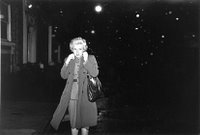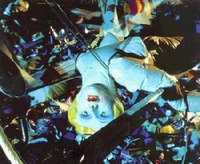
"Our Backstreets" #3
Cindy Sherman: Deconstructing Image
While browsing through the television offerings late in December, I came across a new documentary airing on PBS called "Imagining America: Icons of 20th Century American Art." This show grabbed my attention because art has long been a passion of mine. I'd venture to say that I have a closer affinity for it than I do for film (though the two certainly are closely related); if I hadn't chosen writing as my career, I most certainly would have tried to become an artist.
So, I tuned in and learned to my great delight that part of this 2-hour documentary would include a segment on Cindy Sherman, one of my favorite artists whose film stills series leaves me breathless with wonder. Imagine my dismay when we were treated to endless footage of Jackson Pollock dripping paint on canvas, a more than healthy dose of Andy Warhol, and about 3 minutes total of Cindy Sherman, including exactly one sentence from the artist herself. The in-depth PBS description of the program doesn't even mention her name! I guess men are still defining our culture, but at least with this blog, I can try to emulate Sherman by attempting to correct the imbalance.
Cindy Sherman (1954- ) is primarily a conceptual artist with a witty and piercing grasp of the manipulations of media (consider the
 iro
iro ny of her art being all but smothered in the PBS show!). Her most famous and recognized works are a series of 70 photographs done from 1977 through 1980 called the "Untitled Film Stills." In each photograph, Sherman depicts herself dressed and made up to appear like characters in B-movie scenes or European art films. Many of the poses seem delibera
ny of her art being all but smothered in the PBS show!). Her most famous and recognized works are a series of 70 photographs done from 1977 through 1980 called the "Untitled Film Stills." In each photograph, Sherman depicts herself dressed and made up to appear like characters in B-movie scenes or European art films. Many of the poses seem delibera tely overwrought, and it would be tempting to compare them with Roy Lichtenstein's gigantic comic book panels of sob sisters in vulnerable situations. However, Sherman infuses her characters with a level of humanity that helps them break free of their iconic status and convey the pain and uncertainty that was at the core of the lives of real women who were objectified in these films.
tely overwrought, and it would be tempting to compare them with Roy Lichtenstein's gigantic comic book panels of sob sisters in vulnerable situations. However, Sherman infuses her characters with a level of humanity that helps them break free of their iconic status and convey the pain and uncertainty that was at the core of the lives of real women who were objectified in these films.A Cindy Sherman photograph dares the viewer to look beyond the surface, to imagine an iconic scenario from the photographed woman's point of view. Those who do not "get" these works of art may not yet be ready to unpeel the packaging of social constructs they have been handed by the world in which they live. It is telling that another artist whose photographs challenge accepted social constructs by portraying homosexual sex and love in all its variety, Robert Mapplethorpe, received avid and creative support from Sherman. When he and Andres Serrano ("Piss Jesus") were censored and lost federal funding in the late 1980s, Sherman produced her "Sex" series--photographs of medical mannequins in sexually explicit poses.
Sherman's later works have an apocalyptic quality to them, appearing to present the world after a nuclear holocast. Debris is
 mashed chaotically onto dark, disturbed backgrounds. Sherman has been quoted as saying about her nightmare images, "it prepares you psychically for the potential for violence in your own life." My own take is that Sherman was very distressed about the real and cultural wars occurring when she made these images and created an unfiltered look at chaos in her own mind and heart. Her latest projects have returned her to the center of her art, posing portrait-style as comic grotesques. It's nice to see she's gotten a sense of humor back, but I miss the edge toward which she had been creeping.
mashed chaotically onto dark, disturbed backgrounds. Sherman has been quoted as saying about her nightmare images, "it prepares you psychically for the potential for violence in your own life." My own take is that Sherman was very distressed about the real and cultural wars occurring when she made these images and created an unfiltered look at chaos in her own mind and heart. Her latest projects have returned her to the center of her art, posing portrait-style as comic grotesques. It's nice to see she's gotten a sense of humor back, but I miss the edge toward which she had been creeping. Just one more thing. Cindy Sherman directed a movie called Office Killer that I just ordered. Look for a review of the film from this singular, important artist of the 20th and 21st centuries. Better yet, look for her art. l


0 Comments:
Post a Comment
<< Home